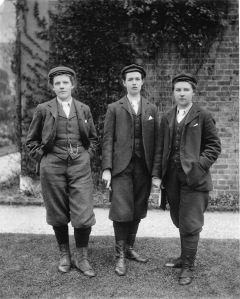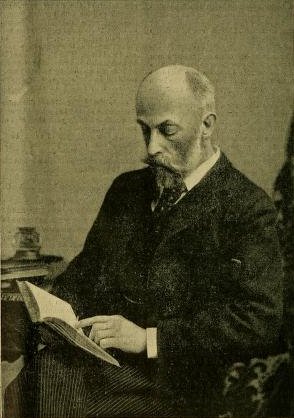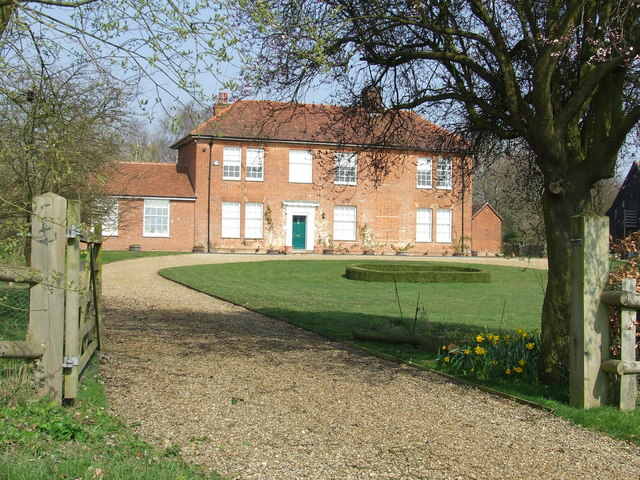|
Alice Hutchins (gardener)
Alice Hutchins (c. 1870 – 24 January 1944) was one of the two first women gardeners hired at Kew Gardens in 1896. Education Hutchins trained at the Horticultural College for Women at Swanley in Kent after it began accepting women in 1891. Her studies were funded by a Kent County Council Scholarship. She received a College Diploma after the two-year program. Kew Gardens In 1896, she and Annie Gulvin were the first women hired by Director William Thiselton-Dyer at Kew Gardens as "improvers". They received the same salary as male staff. They initially wore the same uniforms as the male garden staff to ensure order and consistency. These bloomers drew media attention and criticism, so they were swapped for skirts. Hutchins worked long hours and performed physical tasks in addition to studying chemistry, botany and horticulture in the evenings. By 1897, she had been promoted to gardener and was responsible for certain houses and frames in the garden. She received top marks ... [...More Info...] [...Related Items...] OR: [Wikipedia] [Google] [Baidu] |
Swanley Horticultural College
Swanley Horticultural College, founded in , was a college of horticulture in Hextable, Kent, England. It originally took only male students but by 1894 the majority of students were female and it became a women-only institution in 1903. Early history The college was registered as The Horticultural College and Produce Company, Limited on 30 January 1889. Businessman Arthur Harper Bond (1853–1940) described how he had wished to "do something in the way of applying scientific principles to fruit-growing" and met a man who offered "his" property at Swanley as its base. Bond occupied the property to set up "the Horticultural College", but it later transpired that the property belonged to naval architect and politician Edward Reed. Bond bought it from Reed as "the only way to extricate myself from a difficult position and save my pet scheme from extinction". The college's lecture theatre was the saloon designed by Reed for SS ''Bessemer'', which had been built to swing on gimbals in ... [...More Info...] [...Related Items...] OR: [Wikipedia] [Google] [Baidu] |
Royal Botanic Gardens, Kew
Royal Botanic Gardens, Kew is a non-departmental public body in the United Kingdom sponsored by the Department for Environment, Food and Rural Affairs. An internationally important botanical research and education institution, it employs 1,100 staff. Its board of trustees is chaired by Dame Amelia Fawcett. The organisation manages botanic gardens at Kew in Richmond upon Thames in south-west London, and at Wakehurst, a National Trust property in Sussex which is home to the internationally important Millennium Seed Bank, whose scientists work with partner organisations in more than 95 countries. Kew, jointly with the Forestry Commission, founded Bedgebury National Pinetum in Kent in 1923, specialising in growing conifers. In 1994, the Castle Howard Arboretum Trust, which runs the Yorkshire Arboretum, was formed as a partnership between Kew and the Castle Howard Estate. In 2019, the organisation had 2,316,699 public visitors at Kew, and 312,813 at Wakehurst. Its site ... [...More Info...] [...Related Items...] OR: [Wikipedia] [Google] [Baidu] |
Annie Gulvin
Annie M Gulvin (18 June 1876 - 1972) was one of the first two women gardeners at the Royal Botanic Gardens, Kew. Early life and education Annie Gulvin was born Mary Ann Gulvin in 1876, the daughter of Charles Gulvin, a police constable, and Mary Ann Hooker. She was one of the first female students at the previously all-male Swanley Horticultural College, and graduated top of her class. The Royal Horticultural Society published rankings of its examinees, and in 1895 Gulvin placed first and won their Silver Gilt Medal. Career In January 1896 Gulvin was appointed, with Alice Hutchins, by William Thiselton-Dyer, then Director of the Royal Botanic Gardens as the first women gardeners at Kew. Gulvin and Hutchins were then joined by Gertrude Cope and Eleanor Morland. The women were employed on equal pay, and were made to wear the same brown woolen uniform as male gardeners, so as not to distract their male colleagues. However, due to the publicity this caused, skirts were t ... [...More Info...] [...Related Items...] OR: [Wikipedia] [Google] [Baidu] |
William Turner Thiselton-Dyer
Sir William Turner Thiselton-Dyer (28 July 1843 – 23 December 1928) was a leading British botanist, and the third director of the Royal Botanic Gardens, Kew. Life and career Thiselton-Dyer was born in Westminster, London. He was a son of William George Thiselton-Dyer (1812-1868), physician and Catherine Jane, née Firminger (1815-1897), botanist. He was educated at King's College School where he was first mathematical scholar, and later proceeded to the medical department of King's College London, where he remained until 1863 when he proceeded to Christ Church, Oxford. Initially studying mathematics at Christ Church, Oxford, he graduated in natural science in 1867. He became Professor of Natural History at the Royal Agricultural College in Cirencester and then Professor of Botany at the Royal College of Science for Ireland in Dublin. In 1872, he became professor at the Royal Horticultural Society in London, being recommended by Joseph Dalton Hooker. Then in 1875, Thiselton ... [...More Info...] [...Related Items...] OR: [Wikipedia] [Google] [Baidu] |
Ipswich
Ipswich () is a port town and borough in Suffolk, England, of which it is the county town. The town is located in East Anglia about away from the mouth of the River Orwell and the North Sea. Ipswich is both on the Great Eastern Main Line railway and the A12 road; it is north-east of London, east-southeast of Cambridge and south of Norwich. Ipswich is surrounded by two Areas of Outstanding Natural Beauty (AONB): Suffolk Coast and Heaths and Dedham Vale. Ipswich's modern name is derived from the medieval name ''Gippeswic'', probably taken either from an Anglo-Saxon personal name or from an earlier name given to the Orwell Estuary (although possibly unrelated to the name of the River Gipping). It has also been known as ''Gyppewicus'' and ''Yppswyche''. The town has been continuously occupied since the Saxon period, and is contested to be one of the oldest towns in the United Kingdom.Hills, Catherine"England's Oldest Town" Retrieved 2 August 2015. Ipswich was a settl ... [...More Info...] [...Related Items...] OR: [Wikipedia] [Google] [Baidu] |
Burstall, Suffolk
Burstall is a village and civil parish in Suffolk, England. Located around west of Ipswich, it is part of Babergh district. The parish includes the hamlet of Burstallhill. Recorded in the Domesday Book as Burgestala / Burghestala. It is in the Belstead Brook electoral division of Suffolk County Council. The south-western boundary of the parish is delineated by Belstead Brook, a tributary of the River Orwell. The A1071 between Ipswich and Hadleigh crosses Belstead Brook at Burstall Bridge. Burstall Hall is ⅔ mile (1 km) northeast from the village. Mill Farm is to the west and Hill Farm to the east. The village hall built in 1910 in memory of John Cranfield. It is a Mock Tudor building with a recent lottery grant improvements. No alcohol is sold in the hall. The Half Moon public house closed in 1968 and the Post office closed in 2006. St Mary's Church The parish church of St Mary has been a Grade I listed building In the United Kingdom, a listed building o ... [...More Info...] [...Related Items...] OR: [Wikipedia] [Google] [Baidu] |
Suffolk
Suffolk () is a ceremonial county of England in East Anglia. It borders Norfolk to the north, Cambridgeshire to the west and Essex to the south; the North Sea lies to the east. The county town is Ipswich; other important towns include Lowestoft, Bury St Edmunds, Newmarket, and Felixstowe which has one of the largest container ports in Europe. The county is low-lying but can be quite hilly, especially towards the west. It is also known for its extensive farming and has largely arable land with the wetlands of the Broads in the north. The Suffolk Coast & Heaths and Dedham Vale are both nationally designated Areas of Outstanding Natural Beauty. History Administration The Anglo-Saxon settlement of Suffolk, and East Anglia generally, occurred on a large scale, possibly following a period of depopulation by the previous inhabitants, the Romanised descendants of the Iceni. By the fifth century, they had established control of the region. The Anglo-Saxon inhabitan ... [...More Info...] [...Related Items...] OR: [Wikipedia] [Google] [Baidu] |
Saint Vincent (Antilles)
Saint Vincent is a volcanic island in the Caribbean. It is the largest island of the country Saint Vincent and the Grenadines and is located in the Caribbean Sea, between Saint Lucia and Grenada. It is composed of partially submerged volcanic mountains. Its largest volcano and the country's highest peak, La Soufrière, is active, with the latest episode of volcanic activity having begun in December 2020 and intensifying in April 2021. There were major territory wars between the indigenous population of the Black Caribs, also called the Garifuna, and Great Britain in the 18th century, before the island was ceded to the British in 1763 and again in 1783. Saint Vincent and the Grenadines gained independence from the United Kingdom on 27 October 1979 and became part of the British Commonwealth of Nations thereafter. Approximately 130,000 people currently live on the island, and the population saw significant migration to the UK in the early 1900s and between the 1940s and 1980s. T ... [...More Info...] [...Related Items...] OR: [Wikipedia] [Google] [Baidu] |
Gold Coast (region)
The Gold Coast was the name for a region on the Gulf of Guinea in West Africa that was rich in gold, petroleum, sweet crude oil and natural gas. This former region is now known as the country Ghana. Etymology and position The Gold Coast, Slave Coast, Pepper Coast (or Grain Coast) and Ivory Coast were named after the main export resources found there, respectively. Early uses of the term ''Gold Coast'' refer strictly to the coast and not the interior. It was not until the 19th century that the term came to refer to areas that are far from the coast. The Gold Coast was to the east of the Ivory Coast and to the west of the Slave Coast. Territorial entities Gold Coast region territorial entities were: * Portuguese Gold Coast ( Portuguese, 1482–1642) * Dutch Gold Coast ( Dutch, 1598–1872) * Swedish Gold Coast (Swedes, 1650–1658; 1660–1663) * Couronian Gold Coast ( Duchy of Courland and Semigallia, 1651–1661) * Danish Gold Coast ( Denmark-Norway, 1658–1850 ... [...More Info...] [...Related Items...] OR: [Wikipedia] [Google] [Baidu] |
Church Mission Society
The Church Mission Society (CMS), formerly known as the Church Missionary Society, is a British mission society working with the Christians around the world. Founded in 1799, CMS has attracted over nine thousand men and women to serve as mission partners during its 200-year history. The society has also given its name "CMS" to a number of daughter organisations around the world, including Australia and New Zealand, which have now become independent. History Foundation The original proposal for the mission came from Charles Grant and George Uday of the East India Company and David Brown, of Calcutta, who sent a proposal in 1787 to William Wilberforce, then a young member of parliament, and Charles Simeon, a young clergyman at Cambridge University. The ''Society for Missions to Africa and the East'' (as the society was first called) was founded on 12 April 1799 at a meeting of the Eclectic Society, supported by members of the Clapham Sect, a group of activist Anglicans who m ... [...More Info...] [...Related Items...] OR: [Wikipedia] [Google] [Baidu] |
Order Of The British Empire
The Most Excellent Order of the British Empire is a British order of chivalry, rewarding contributions to the arts and sciences, work with charitable and welfare organisations, and public service outside the civil service. It was established on 4 June 1917 by King George V and comprises five classes across both civil and military divisions, the most senior two of which make the recipient either a Orders, decorations, and medals of the United Kingdom#Modern honours, knight if male or dame (title), dame if female. There is also the related British Empire Medal, whose recipients are affiliated with, but not members of, the order. Recommendations for appointments to the Order of the British Empire were originally made on the nomination of the United Kingdom, the self-governing Dominions of the Empire (later Commonwealth) and the Viceroy of India. Nominations continue today from Commonwealth countries that participate in recommending British honours. Most Commonwealth countries ceas ... [...More Info...] [...Related Items...] OR: [Wikipedia] [Google] [Baidu] |





